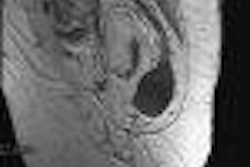The achilles is the most commonly injured ankle tendon, and its injury is associated with significant morbidity. About 15% of affected athletes can’t return to their chosen sport even a year after diagnosis, according to Dr. Bruce Forster of the Vancouver Hospital in Vancouver, BC.
Unfortunately, the success of ultrasound and MRI in this application has not been conclusively determined from the literature, said Forster, who presented results from a comparative study at his institution at last year's RSNA meeting.
In the literature, false positive and negative rates for ultrasound vary considerably, although it’s been suggested that color or power Doppler may help increase the sensitivity and specificity of the modality. MRI, on the other hand, has turned in a somewhat better performance in prior studies, but many of these studies relied on a histologic gold standard. This biases the study sample to more severe cases, Forster said.
To get a better look at the performance of MRI and optimized ultrasound in this application, the Vancouver researchers prospectively compared the modalities to a clinical gold standard for the evaluation of chronic achilles tendon sports injuries.
Forty-five patients with chronic symptoms in 57 tendons were evaluated and diagnosed with chronic achilles tendonopathy, partial tear, insertitis, or retrocalcaneal bursitis by one of two sports medicine physicians. The injuries were graded by means of a scoring system.
All patients underwent ultrasound (12-MHz probe) with color and power Doppler imaging. Imaging was performed bilaterally on symptomatic and asymptomatic tendons by a radiologist who was blinded to the symptomatic tendon side, Forster said. The size and number of lesions were calculated, as was tendon thickness.
In addition, a cohort of 25 consecutive patients also received MRI with high-resolution, T1-weighted and fast spin echo T2-weighted fat saturation sequences.
Ultrasound correctly identified 22 of 33 (66%) asymptomatic tendons as being normal, and 37 of 57 (65%) symptomatic tendons as being abnormal, according to the researchers. The addition of color and power Doppler didn’t improve the diagnostic performance of ultrasound, Forster said. MRI, on the other hand, correctly identified 15 of 16 (94%) asymptomatic tendons as normal, and 19 of 34 (56%) symptomatic tendons as abnormal.
Thirty-six patients (with 45 symptomatic tendons) were available for follow-up a year later. Scoring grade of severity from the ultrasound and MRI diagnosis was not predictive of outcome at one year, he said.
Based on comparison with a rigorous gold standard, ultrasound and MRI studies do not offer sufficient diagnostic accuracy to warrant routine use in the workup of chronic achilles tendon disorders, Forster said.
"However, we used very stringent clinical parameters for a gold standard, and from a family practice referral standpoint, MRI and ultrasound may play a role in the assessment of achilles tendon pain, or with clinicians who are less experienced in assessing the tendon," he said.
By Erik L. RidleyAuntMinnie.com staff writer
January 12, 2001
Click here to post your comments about this story. Please include the headline of the article in your message.
Copyright © 2001 AuntMinnie.com




.fFmgij6Hin.png?auto=compress%2Cformat&fit=crop&h=100&q=70&w=100)




.fFmgij6Hin.png?auto=compress%2Cformat&fit=crop&h=167&q=70&w=250)











